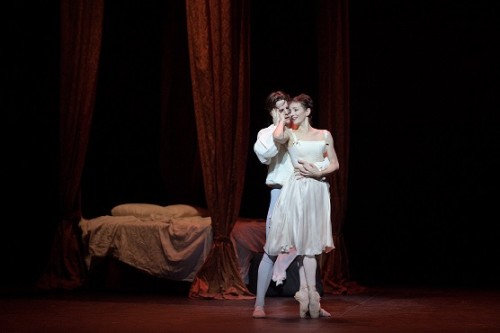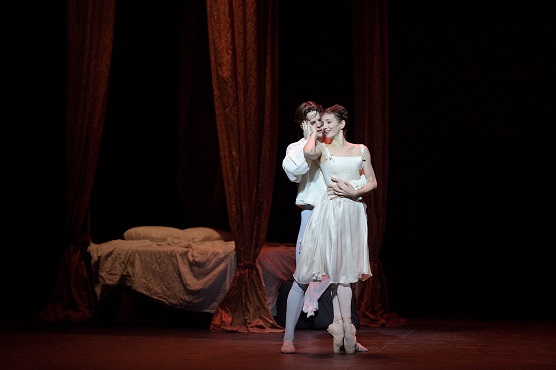 United Kingdom Massenet, Manon (choreography by Sir Kenneth MacMillan): Dancers of English National Ballet, English National Ballet Philharmonic / Gavin Sutherland (conductor). London Coliseum. 16.1.2019. (JPr)
United Kingdom Massenet, Manon (choreography by Sir Kenneth MacMillan): Dancers of English National Ballet, English National Ballet Philharmonic / Gavin Sutherland (conductor). London Coliseum. 16.1.2019. (JPr)

Production:
Choreography – Kenneth MacMillan
Orchestration – Martin Yates
Designs and Costumes – Mia Stensgaard
Lighting – Mikki Kunttu
Cast
Manon – Alina Cojocaru
Des Grieux – Joseph Caley
Lescaut – Jeffrey Cirio
Monsieur GM – James Streeter
Lescaut’s Mistress – Katja Khaniukova
Madame – Jane Haworth
Gaoler – Fabian Reimair
Beggar Chief – Noam Durand
Lady Deborah MacMillan, the choreographer’s widow, writes in the programme how ‘Manon is a ballet for a large company one that has mature artists as well as very young dancers just beginning their careers. It contains a wealth of roles to exploit the strengths of a company, and English National Ballet has all the ingredients to make the story come alive.’ While I have considerable doubts about Kenneth MacMillan’s Manon itself, undoubtedly this was another considerable achievement for ENB who are currently cementing their status in the top flight of the world’s ballet companies.
Having not too long ago endured the misogyny and gang rape of his final work, The Judas Tree, it is clear MacMillan might have had certain issues with women and that is possibly why he was attracted to the story of Manon which originated in Abbé Prévost’s 1731 novel. Manon’s ‘encounter’ with the Gaoler in Act III is rather lurid and voyeuristic given that most of the choreographed sex we have seen earlier is extraordinarily tame and passionless by comparison. Lady MacMillan also wrote: ‘I do not always say yes when a ballet company approaches me wanting to acquire the work’ and I guess revisioning the setting to the casting couch antics of the Golden Age of Hollywood would be out of the question? Though this was not repeated in this introduction, I once heard Lady MacMillan reveal Sir Kenneth’s obsession with ice skating and how this was the inspiration behind all the swirling pas de deux. If you have this in mind when you see his Manon you will recognise it in so much of the choreography.
This three-act narrative ballet begins (supposedly) in the bustling courtyard of an inn near Paris and ends in the murky swamps of Louisiana. Along the way there is everything you would find in a modern soap opera though with added dancing! There is stealing, illicit love, jealousy, murder, wrongful conviction and sexual abuse. It is the sort of dark story that apparently appealed to MacMillan and has a very downbeat ending that was unusual when compared to many popular fairy tale ballets, though not of course his earlier Romeo and Juliet. Manon is a fickle young woman who abandons her journey to a convent after she falls for the handsome, though penniless, Des Grieux, but is quick to abandon him for the luxuries offered by a rich roué Monsieur GM whom she doesn’t love. The setting is eighteenth-century Paris where people appear either rich and powerful, taking a lascivious interest in the lives of the demi-monde, or poor and destitute where criminality and/or prostitution are their only options to survive. Everyone has a price it seems.
Once Manon sets off on her chosen path she seems to be on a loser whatever option she chooses; her choice to eventually flee Paris after a series of unfortunate events – including helping Des Grieux cheat to win money playing cards and then the death of her pimp-like brother Lescaut – has fatal consequences. Weak, emaciated and hallucinating, she dies in the arms of her lover in a Louisianan swamp. Is she a victim or has she brought this on herself? I will leave others to debate this, though I appreciate MacMillan’s Manon is a product of an age when the depiction of violence against women seemed de rigueur in popular culture.
Another major weakness is the score and though the ballet has music by Massenet – originally arranged by Leighton Lucas in collaboration with Hilda Gaunt and re-orchestrated by Martin Yates – it does not include a note from the composer’s opera with the same plot and title. Undoubtedly Massenet did write some lovely melodies, and even though the arrangers shrewdly incorporate one of his best-known tunes, the lovely and reflective Élégie, into each of the three acts, it has always sounded a Classic FM-like potpourri. Some of Act II reminds me of Don Quixote, although when Manon become the plaything of a group of men we hear hints of Tchaikovsky’s Arabian Dance from The Nutcracker. Finally, Act III cranks up the romantic ecstasy when something sparer and much more poignant would be better. The English National Ballet Philharmonic were as magnificent as ever under Gavin Sutherland, yet what we heard from the pit was often undoubtedly at odds with the underlying themes of what we were watching.
I wrote ‘supposedly’ above concerning what we should be seeing. This refers to the fact this is a touring production from The Royal Danish Ballet with designs by Mia Stensgaard. With moveable flats, furniture, carriages, candelabras, a slightly risible cut-out ship’s prow, and copious amount of dry ice, the audience needs to use its imagination for a courtyard, a bedroom, a salon, New Orleans’s harbour or a swamp. With some atmospheric lighting from Mikku Kunttu everything was serviceable, but little else, and looked a bit lost on the vast London Coliseum stage. There were opulent period costumes but some odd choices at times with the scene-stealing Act II Degas-like prostitutes having the puffiest of puffy dayglo skirts and then some candy-striped girls at the quayside in Act III.
Praise is due to Sir Anthony Dowell, Vivian Durante, Dmitri Gruzdyev, Gary Harris, and Irek Mukhamedov for their consummate work on bringing this Manon into the ENB’s repertory and ensuring splendidly committed performances at every level from those at the very back of the stage to the leading dancers at its centre. In this ballet those around the fringes are almost as important as the principals in creating the proper background for the central tale of the two doomed lovers. The ENB continues to be in great shape, no one appeared to switch off, and the corps de ballet danced admirably. Manon’s choreography has complicated lower body work, some extravagant lifts, much rolling, dropping to the floor, slides and glides, as well as, some leaping for the townspeople and beggars. Throughout MacMillan conflates a variety of ballet styles and incorporates trios as well as duets and solo work. The outcome however is that the destitution, depravity and passion appear somewhat sanitised for 2019. Whether this has been diluted through endless revivals I cannot be certain, as – apart from recent cinema broadcasts – it was in the 1980s when I last saw the ballet at Covent Garden and that is a long time ago!
Alina Cojocaru has danced the role of Manon for some time now and is still perfection personified. Her acting and dancing was unforced, unmannered and totally natural; her arms fluid and her leg and footwork crisp. With her hair shorn and in ragged clothes, Cojocaru was barely recognisable as the woman who luxuriated in being bejewelled and draped in furs in Act II. Whether playfully revelling in being alone with Des Grieux in his bedroom or being forced to ‘pleasure’ the Gaoler (Fabian Reimair), Cojocaru’s interpretation was captivating and once she is in the spotlight – truthfully she could be a little lost in all the hustle and bustle sometimes – I could not take my eyes off her.
The trouble I have with Des Grieux is that the role was choreographed in 1974 for Anthony Dowell and he can still be seen in all the character’s languid steps whether imploring or reflective. For much of the ballet Joseph Caley – a dancer with a clean technique – had a puppy-dog devotion to Manon and there was a lack of real passion in the famous Act I bedroom scene antics, though this is often the case. However when Caley finally broke sweat at the end of the ballet his pain and devotion for Manon was palpable and his reaction to her death was heart-wrenching.
Jeffrey Cirio portrayed Manon’s conniving brother Lescaut – who is willing to make a profit from his sister’s virtue – and he looks to be a mightily impressive ‘signing’ for ENB. This thoroughly despicable character gets a cleverly choreographed drunk scene in Act II as he tries to partner Katja Khaniukova who excelled as his mistress. Every step Lescaut takes is off balance, but Cirio – a dancer of great physical and expressive potential – timed each (mis)step expertly. This, together with a few other of Manon’s longueurs, hints at an entirely different ballet: for instance, Lescaut gets a swordfight lifted straight from MacMillan’s Romeo and Juliet.
James Streeter was the aristocrat Monsieur GM and his haughty mien left no doubt that he was always used to getting whatever he wanted in life. When he was with Manon – the woman he has cynically bought – he loses control and can hardly keep his hands off her and his lustful pawing and foot fetishism was suitably distasteful. Amongst the smaller roles, Jane Haworth’s elegant, yet unscrupulous, Madame was another impressive vignette from her and Noam Durand’s Beggar Chief caught the eye as somewhat of a whirling dervish.
Jim Pritchard
For more about English National Ballet click here.

I agree with almost every word of this review, especially those about Macmillan’s rather odd relationship with his principal ladies, and the music, which is grinding, turgid stuff. But the dancing, ENB’S production is sublime, it’s got a spontaneous sparkle that is totally lacking in ROHs polished productions. Absolutely glorious.